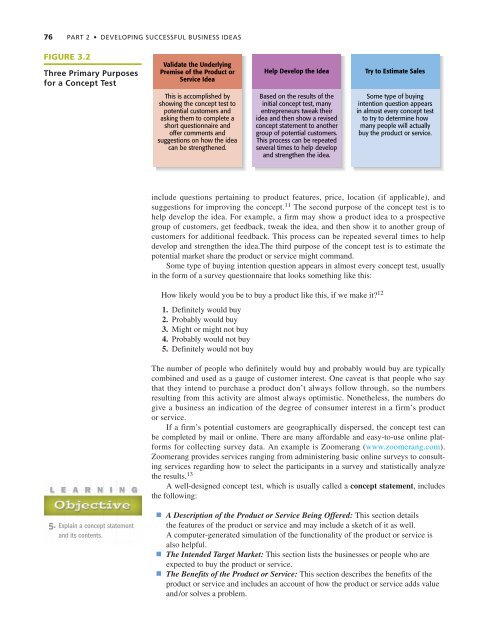feasibility analysis feasibility analysis
feasibility analysis feasibility analysis
feasibility analysis feasibility analysis
You also want an ePaper? Increase the reach of your titles
YUMPU automatically turns print PDFs into web optimized ePapers that Google loves.
76 PART 2 • DEVELOPING SUCCESSFUL BUSINESS IDEAS<br />
FIGURE 3.2<br />
Three Primary Purposes<br />
for a Concept Test<br />
Validate the Underlying<br />
Premise of the Product or<br />
Service Idea<br />
Help Develop the Idea<br />
Try to Estimate Sales<br />
This is accomplished by<br />
showing the concept test to<br />
potential customers and<br />
asking them to complete a<br />
short questionnaire and<br />
offer comments and<br />
suggestions on how the idea<br />
can be strengthened.<br />
Based on the results of the<br />
initial concept test, many<br />
entrepreneurs tweak their<br />
idea and then show a revised<br />
concept statement to another<br />
group of potential customers.<br />
This process can be repeated<br />
several times to help develop<br />
and strengthen the idea.<br />
Some type of buying<br />
intention question appears<br />
in almost every concept test<br />
to try to determine how<br />
many people will actually<br />
buy the product or service.<br />
include questions pertaining to product features, price, location (if applicable), and<br />
suggestions for improving the concept. 11 The second purpose of the concept test is to<br />
help develop the idea. For example, a firm may show a product idea to a prospective<br />
group of customers, get feedback, tweak the idea, and then show it to another group of<br />
customers for additional feedback. This process can be repeated several times to help<br />
develop and strengthen the idea.The third purpose of the concept test is to estimate the<br />
potential market share the product or service might command.<br />
Some type of buying intention question appears in almost every concept test, usually<br />
in the form of a survey questionnaire that looks something like this:<br />
How likely would you be to buy a product like this, if we make it? 12<br />
1. Definitely would buy<br />
2. Probably would buy<br />
3. Might or might not buy<br />
4. Probably would not buy<br />
5. Definitely would not buy<br />
The number of people who definitely would buy and probably would buy are typically<br />
combined and used as a gauge of customer interest. One caveat is that people who say<br />
that they intend to purchase a product don’t always follow through, so the numbers<br />
resulting from this activity are almost always optimistic. Nonetheless, the numbers do<br />
give a business an indication of the degree of consumer interest in a firm’s product<br />
or service.<br />
If a firm’s potential customers are geographically dispersed, the concept test can<br />
be completed by mail or online. There are many affordable and easy-to-use online platforms<br />
for collecting survey data. An example is Zoomerang (www.zoomerang.com).<br />
Zoomerang provides services ranging from administering basic online surveys to consulting<br />
services regarding how to select the participants in a survey and statistically analyze<br />
the results. 13<br />
A well-designed concept test, which is usually called a concept statement, includes<br />
the following:<br />
5. Explain a concept statement<br />
and its contents.<br />
■ A Description of the Product or Service Being Offered: This section details<br />
the features of the product or service and may include a sketch of it as well.<br />
A computer-generated simulation of the functionality of the product or service is<br />
also helpful.<br />
■ The Intended Target Market: This section lists the businesses or people who are<br />
expected to buy the product or service.<br />
■ The Benefits of the Product or Service: This section describes the benefits of the<br />
product or service and includes an account of how the product or service adds value<br />
and/or solves a problem.

















